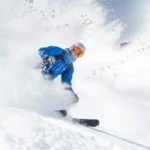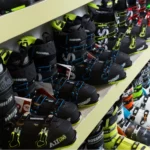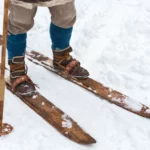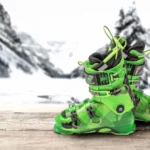Ski Boot Buying Guide

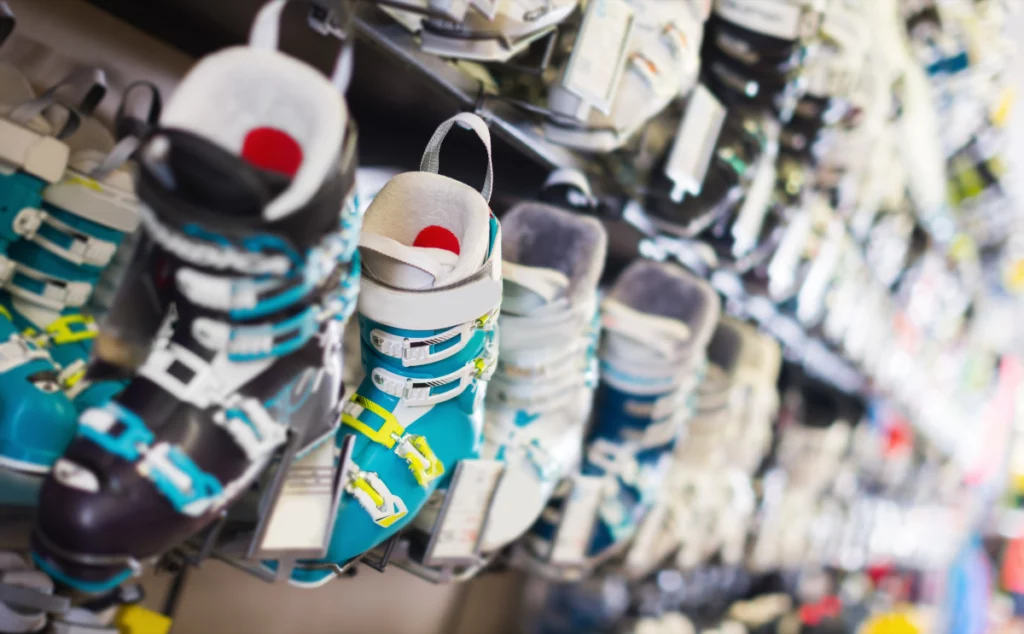
With more than 100 styles to choose from, finding the right ski boot can be overwhelming. Popular manufacturers introduce new boots each year that reflect the latest advancements in materials and technology while maintaining their existing models while supply and demand last.
Ski boots are the most critical aspect of ski gear: they transfer the control and intent from your body to the skis. If your ski boot is too loose, your feet will float inside the boot, making it impossible to maintain control. Boots that are too tight will not only cause pain and discomfort but can impede circulation which will result in cold, numb feet.
How to pick the right ski boot
The most important aspect of a ski boot is the fit, which is measured for four different areas: length, width and volume, and cuff. The best ski boot for you is one that accommodates your foot in all four areas. Identifying how a ski boot should fit you in these four aspects will help you quickly narrow down the brand and model that are right for you.
You also need to consider the flex, or stiffness, of the boot. Stiffer boots, with a higher flex rating, provide more control and responsiveness, while softer boots are more comfortable and forgiving. As your skiing skills grow, you will want to seek stiffer and tighter-fitting boots for better performance.
Lastly, you can further narrow down your ski boot options by considering the type of skiing you plan to do. Keep in mind what type and range of slopes you want to ski, and whether or not a ski walk mode is important.
Ski Boot Size and Mondopoints
Ski boots are measured in Mondopoint units, an international foot measurement standard that represents the length of your foot, from heel to tip of the longest toe, in centimeters. For example, a 27 Mondo size translates to 270mm, which roughly translates to a U.S. men’s size 9. Beginner skiers should start with the exact Mondopoint boot size, while intermediate or advanced skiers often opt for a half or full Mondopoint size smaller in order to achieve a snug fit and optimize the ski boots for performance. The sizes do differ between women’s ski boots and men’s ski boots.
| Mondopoint (Comfort Fit) | Mondopoint (Performance Fit) | Mens (US) | Womens (US) |
| 24 | 23 | 6 | 7 |
| 24.5 | 23.5 | 6.5 | 7.5 |
| 25 | 24 | 7 | 8 |
| 25.5 | 24.5 | 7.5 | 8.5 |
| 26 | 25 | 8 | 9 |
| 26.5 | 25.5 | 8.5 | 9.5 |
| 27 | 26 | 9 | 10 |
| 27.5 | 26.5 | 9.5 | 10.5 |
| 28 | 27 | 10 | 11 |
| 28.5 | 27.5 | 10.5 | 11.5 |
| 29 | 28 | 11 | 12 |
| 29.5 | 28.5 | 11.5 | 12.5 |
| 30 | 29 | 12 | 13 |
| 30.5 | 29.5 | 12.5 | 13.5 |
Last – Ski Boot Width
Ski boots come in various widths, referred to as “last” in the ski industry. The last represents the widest part of the boot, typically the portion where the ball of your foot hits, in millimeters. Typically, manufacturers produce boots with lasts ranging from 97mm to 106mm. If your foot falls outside this range, you will likely need to seek out a specialty model.
Most manufacturers make two or three different lasts, narrow, medium, or wide, which are reflected in a letter grade. An “A” or “B” foot width usually aligns best with narrow lasted boots; “C” and “D” with a medium; and “E” with a wide last. Wider ski boots will generally also have increased volume elsewhere in the boot.
| Narrow | Medium | Wide |
| 97mm – 98mm | 99mm – 101mm | 102mm – 106mm |
Cuff Shape
A ski boot’s cuff shape and alignment play a crucial role in the fit around the upper portion of the foot and the calf. Cuff shape needs differ depending on whether you’re male or female, as women’s calves tend to sit lower on the leg than men’s.
Manufacturers provide a wide range of cuff shapes, and many boot models allow for the adjustment of the cuff alignment. Additionally, a large number of boot models now allow the adjustment of the cuff angle by modifying the rivets that connect the cuff to the shell. This feature makes boots more supportive of skiers with a knocked-knee or bow-legged stance.
Shell
Matching a shell shape with your foot shape is the first step to finding the right boot.
Ski boot shells are made from various types of hard plastic. Some shells are made out of heat-moldable plastic that can be customized by professional boot fitters to achieve the perfect fit. Having your boots customized to your fit can alleviate pressure points, or accommodate more closely the actual width of your feet.
Liner
Ski boot liners are removable inserts that fit inside the shell. Their purpose is to provide protection, insulation, and comfort.
Liners are made out of foam and other materials that usually conform to the shape of your foot after a few wears. This is known as “packing out”, and will lead to a less snug fit than you initially experienced when you first tried on your boots. With that in mind, you should be looking for a fit that’s perhaps slightly too snug in the store in order to make up for the materials’ future compression.
Thermo-formable foam liners offer advanced customization through heat molding techniques that soften the liner. Once softened and placed into the boot, you place your foot inside the boot so that the liner can conform to its exact shape. This fitting process is best done by a qualified boot fitter.
Flex
The flex number indicates the stiffness and pushback you will feel from the boot when you bend your ankle forward. Stiffer boots provide better energy transfer from your leg to the ski.
Flex numbers typically range from 60 (soft) to 140 (stiff). However, there is no standard for flex numbers and experienced skiers will notice a difference if switching between brands.
Your weight, skill level, and desired performance will all impact your choice of flex. Beginners often aim for a lower flex number. Intermediate skiers will target a flex range from 80 to 110, while advanced skiers will go for a flex range of 110 to 130. Anything above a flex of 130 is typically only needed for performance skiing.
| Women’s Flex | Men’s Flex | |
| Beginner – Intermediate | 50 – 65 | 50 – 85 |
| Intermediate – Advanced | 70 – 85 | 90 – 100 |
| Advanced – Expert | 90 – 110 | 110 – 130 |
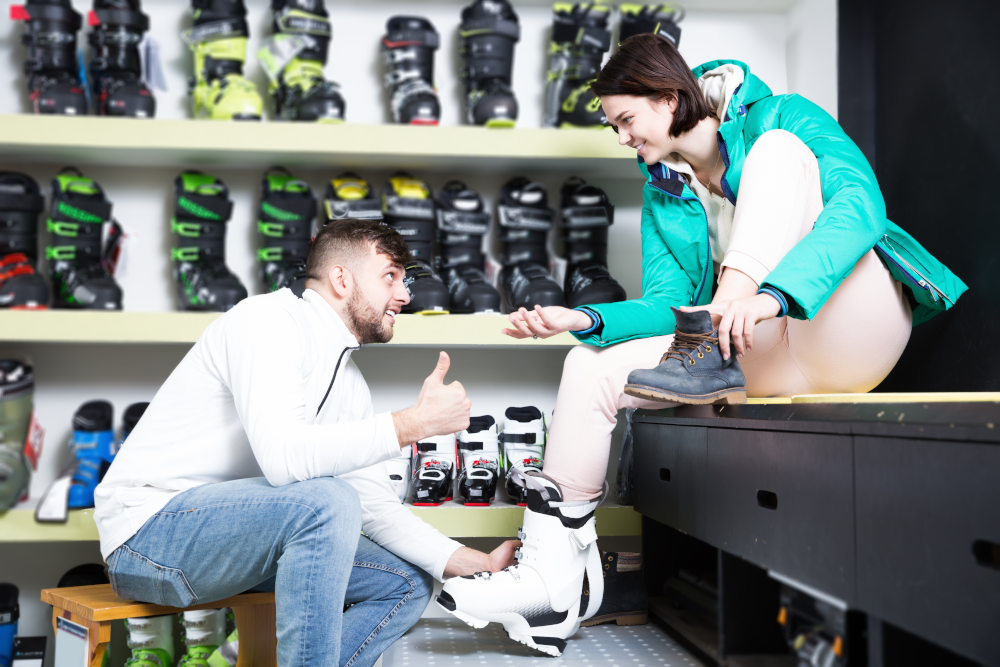
Sizing tips when trying on Ski Boots
A good-fitting ski boot should have a snug feel that doesn’t activate any major pressure points that trigger pain and discomfort. With brand-new boots, it is OK to feel a slight pressure on your toes when standing because the boot will stretch out after a few days. If your foot is sliding inside the boot, you need to size down.
Make sure to bring ski socks to your fitting, and to try the boot fit on both feet given that the size of your feet likely don’t match exactly. The following tests will help ensure the best possible fit.
The shell test
The shell test ensures that the ski boot shell fits your foot length well. After removing the liner, place your foot inside the shell and slide it to the front so that the toe gently touches the front of the shell. Slide your fingers between your heel and the back of the shell, taking note of how many fingers you can fit comfortably.
A good size will allow you to roughly fit two fingers, ~0.6 inches. Performance skiers will go for less space, about one to one and a half fingers. More than two fingers typically indicate that the boot is too big.
Standing test
The standing test can help you determine whether or not the boot shell liner size and shape are a good fit. With the liner inside the shell, place your (socked) foot inside the liner, and fasten the boot. Tap the heel of your boot to the ground to drive your heel into the boot heel pocket, and then double-check that all the buckles are appropriately tightened.
Then, stand up. As your foot slides forward, take note of where your toes are in relation to the front of the liner. If they are just touching, you’ve got the right fit. If they feel pressed, then you need to size up; if you don’t feel the liner at all, size down.
Leaning test
The leaning test will check to make sure that the shape and volume of the boot are a good fit for your foot. With your foot secured inside the boot, squat down slightly and lean forward so that your shins lean against the tongue of the boot. Your heel should remain snug and secure in the heel pocket. If it does not, and it lifts, the ski boot is too big.
Also, your toes should not feel overly cramped against the front of the liner; if they do, the boot is too small. Light touching of the front of the boot and feeling slight pressure is good since the boot will pack out.
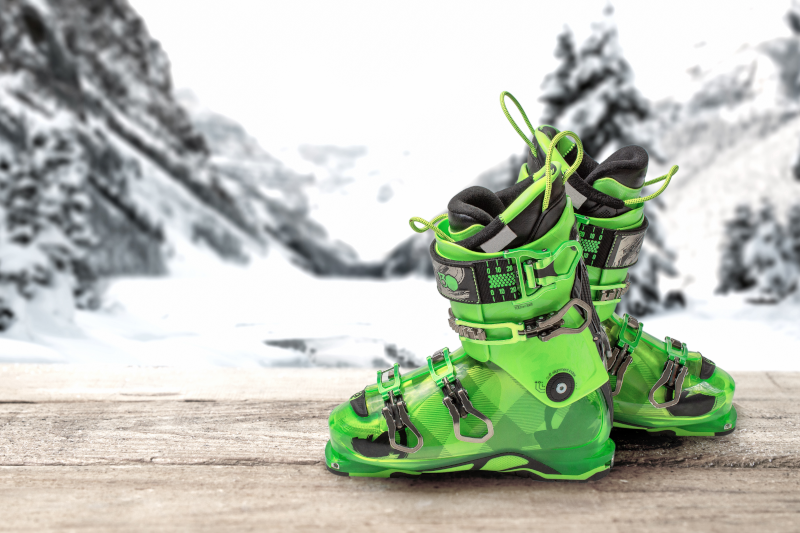
Other Ski Boot Features to Consider
Buckles
Buckles tighten and secure the ski boot to your foot. Older models generally include more buckles for a better fit, while newer models rarely feature more than four buckles, and the buckle closest to the toes does very little for the fit.
Having fewer buckles means you’ll likely need less time to put on your boots and make sure everything is adjusted properly. And if you find the right boot, you won’t need more than four buckles to ensure an optimal fit.
Some boot buckles allow for micro-adjustments, where you can rotate buckles clockwise or counterclockwise to make small adjustments. Other boots allow you to slide and adjust the buckle ladder in order to achieve a better fit with the buckles.
Power Strap
The power strap sits at the very top of the cuff and is usually a velcro strap that tightens the top part of the boot. A snug fit between your shin, calf, and boot liner increases the transmission of control to the skis.
Walk mode
More ski boots – particularly crossover and alpine touring models – feature the walk mode toggle. This allows the boot to go from the fixed ski mode to the walk, allowing a greater range of motion. This feature makes walking in ski boots or climbing uphill using skins much easier.
Soles
The soles of your ski boots can wear down quickly if you walk on asphalt and rock. Modern boots have swappable soles so that they can be replaced if worn out; you can also opt for different grip patterns or even rockered soles such as the popular Gripwalk soles. They have a slight curvature and can convert your boot from an alpine boot to a touring boot which makes hiking and walking in boots easier. If your boot has Gripawalk soles you’ll want to make sure your ski bindings will work with them.
Customizing your ski boots with a boot fitter
The ultimate ski boot comfort can be achieved by customizing the boots to your feet. Many ski shops have professional boot fitters on staff who use various techniques, such as punching or heat molding, to customize the ski boot for your foot.
These processes can be expensive, and not all boots are equally customizable. If you think that you are not able to get the right fit with any boot off the shelf, you’ll need to look for ski boot models that can be adapted for you.
Common mistakes when picking ski boots
Choosing too comfortable ski boots
A common mistake ski boot buyers make is choosing boots that feel too comfortable in the store, only to have them end up being too big once they pack out. A ski boot should feel slightly too snug when it’s brand new.
Not trying ski boots on both feet
The differences may not be noticeable to the naked eye, but none of us have two feet that are exactly alike. It is crucial to try the ski boots on both feet and make sure they fit well.
Focusing on the style and color first
Although great looking ski boots surely contribute to your look, prioritize fit over flair to ensure you’re equipped for a good day on the slopes.
Not considering your skiing level
A beginner skier should not get performance-level ski boots, as they will not provide the flexibility and forgiveness you need when learning to ski. Meanwhile, an advanced skier planning to tackle challenging terrain will find it difficult to have precise control without stiffer ski boots.
Not trying boots on with the right socks
Ski boots require a snug fit, and the thickness of your sock contributes to that. Trying on ski boots without ski socks could lead you to get the wrong size or shape of boot.
Going for the deal
Ski boots are expensive, so it’s understandable that you may be tempted to go for a bargain. But if you compromise now on price, you will likely also compromise later on comfort and performance.
Conclusion
Finding the right ski boots is critical to ensuring you have a good day on the slopes. Both your comfort and ability to ski at the level you desire start with properly fitting ski boots. Take your time to test the fit with the tests we recommend above. The extra time and effort will set you on the right course to pick the right ski boots. Finally, if you have special requirements it’s best to consult with a professional boot fitter.
